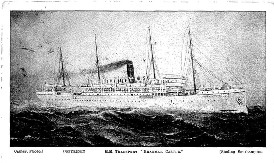Reading Out Loud
Focused Elements:
You can have these explanations read out loud by clicking on 'Speak Explanation' (access key 'a')
These controls are to provide alternative means of accessing the information on this page. Two main facilities are provided: adjusting the text size and listening to the text on the page.
1) Adjusting Text Size:
You can increase the text size by clicking on 'Larger' (access key '+'), and reduce it by clicking on 'Smaller' (access key '-'). You can reset the size back to its original value by clicking on 'Reset' (access key 'j')
2) Listening to the Text
You can adjust the pitch of the spoken word, the rate or speed of delivery and the volume. You can also choose the voice to use by clicking on the drop-down list. The default voice is whatever is the standard for the computer and browser you are using.
To set your default, please refer to the description in the Accessibility Statement.
There are normally three sections of text on the page that you can listen to: the headings, the main text and a selection. Click on 'Speak Headings to speak the page headings (access key 'l'). Click on 'Speak Main Text' (access key 'q') to listen to the main text.
You can also select an area of text in the page using standard select methods and click on 'Speak Selection' (access key 'w') to read the selection aloud.
You can enable the reading out loud of the element that currently has focus by clicking on 'Start Focus Speaking' (access key 'f') and you can stop this by clicking on 'Stop Focus Speaking' (access key 'd').
You can pause the audio by clicking on 'Pause' (access key 'r') and resume by clicking on 'Resume' (access key 't').
To cancel or stop the audio click on 'Cancel' (access key 'y'). To restart the current audio from the beginning, click on 'Restart' (access key 'k').
To hide the accessibility controls click on 'Hide Panel' (access key 'h')
To hide this explanation click on 'Hide Explanation' (access key 'x')
Widecombe-in-the-Moor
SS Braemar Castle

From DVD: RND Royal Naval Division. From 1916 63rd (RN) Division. W.W.1. 1914-1919. Antwerp, Gallipoli, Western Front. Magazine Issues 1-24, pages 1 to 2443. Copyright © Leonard Sellers 1998, Produced and designed at 17a Bellhouse Road, Eastwood, Leigh-on-Sea, Essex, SS9 5NL.
This extract is from Issue Number 19 pages 1885 - 1886
SHIPS THAT TRANSPORTED THE R.N.D. H.M.T. BRAEMAR CASTLE

Post Card the property of Len Sellers, dated 6pm 18th Sept 1907. States :-- Arrived on board we sail at 3 O'Clock, don't answer it, it will get lost. --
Commissioned in 1898, with a top speed of 15 knots (6266 gross tonnage). It was a four n-lasted intermediate ship, built by Barley Curle & Co. She was given quadruple- expansion engines having a single screw propulsion system. The ship was fitted out for lst & 2nd class passengers. She became a successful ship and would most likely have been followed by further ships of the same type, had the Union Castle Line merger not have taken place. Used on the Cape Run until 1909, she was then chartered by the Government and used in 1915 as a transport for the Mediterranean Expeditionary Force.
On the 6 February 1915 she sailed for Gallipoli with 1041 passengers in the form of the Royal Naval Division's H.Q. 3rd Brigade, No 4 Sec Signal Company and the Plymouth Battalion, R.M.L.l. With her was H.M.T. Cawdor Castle with 1008 members of the Chatham Battalion.
The Braemar Castle took part in the raid of the 4th March, at Kum Kale, a village situated on the Asian shore, alongside the Dardanelles. Later, she was converted into a Hospital Ship. However on 23rd November 1916 the ship, bound from Salonika to Malta with sick and wounded, suffered an explosion under its port side. lt had struck a mine, when passing Joannis Point, one mile east of the island of Tinos. She was beached and waited to be repaired in 1918 at Spezia. There followed in 1920 use as an Allied Base Hospital at Murmansk . At this stage in her life the vessel lay for nearly a year, providing increased accommodation. To keep out the cold her decks were boarded in, and in consequence the men called her "Noah's Ark". For nearly 12 months, she lay packed in ice. Everyday, parties of Russian refugees were set to work to break the ice, which threatened to "pinch" the ship. Later, she made further intermediate sailing's in its owner's service, but in 1921 reverted to a troop carrier, until it was decided in 1924, that she had ended her usefulness, so the vessel was scrapped in Italy. Many distinguished persons sailed in her including Sir Ernest Shackleton the explorer.
References: -
Research at Greenwich Maritime Museum, library.
"The Cape Run" by W.H. Mitchelle & L.A. Sawyer. Published by Terence Dalton, Suffolk in 1984. ISBN 0 86138 (>304. Pages 21 & 170.
"Union Castle Chronicle" by Marischal Murray. Published by Longman's Green & Co. in 1953. Page 174.
Public Record Office, Kew. ADM 1 37/3642. Loss of Hospital Ship, Braemar Castle on 13/11/16.
Roll of Honour :- The only death of the crew recorded is that of G. S. Holbeck a Sub Lieutenant R.N.R. who died in Hasler Hospital.
Detail from "Union Castle And The War" 1914 - 1919. By E. F. Knight, 1920. Published by The Union-Castle Mail Steamship Co. Ltd. 3-4 Fenchurch Street, London E.C.
The information on this page was last modified on August 02 2017 10:39:28.


